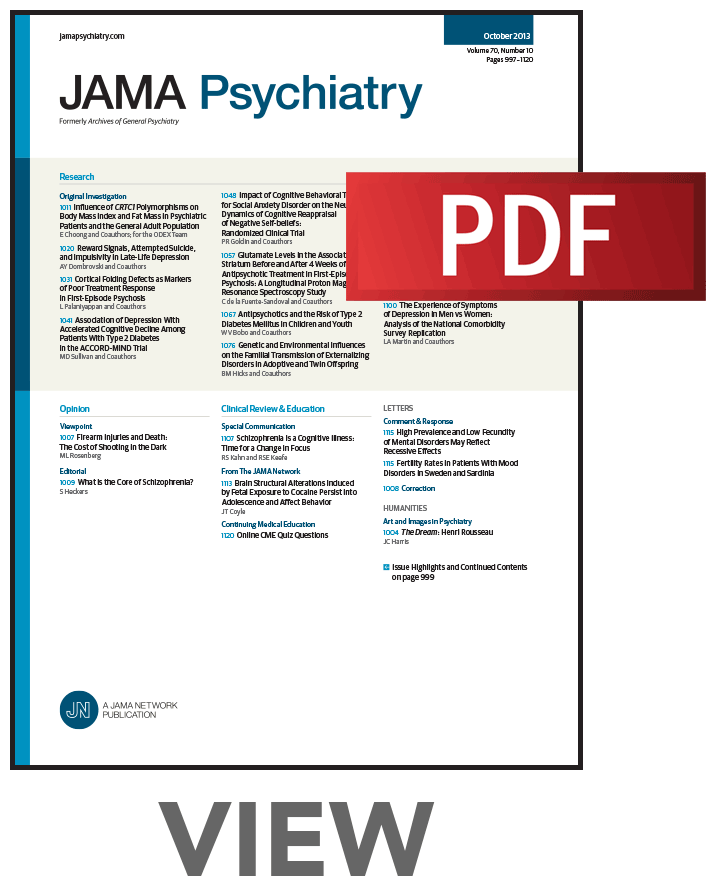Neurofilament Light Chain and Differentiation of Behavioral Variant Frontotemporal Dementia From Psychiatric Disorders: A Systematic Review.
IF 17.1
1区 医学
Q1 PSYCHIATRY
引用次数: 0
Abstract
Importance Behavioral variant frontotemporal dementia (bvFTD), the most common subtype of FTD, is a leading form of early-onset dementia worldwide. Accurate and timely diagnosis of bvFTD is frequently delayed due to symptoms overlapping with common psychiatric disorders, and interest has increased in identifying biomarkers that may aid in differentiating bvFTD from psychiatric disorders. Objective To summarize and critically review studies examining whether neurofilament light chain (NfL) in cerebrospinal fluid (CSF) or blood is a viable aid in the differential diagnosis of bvFTD vs psychiatric disorders. Evidence Review A systematic review was conducted, searching PubMed, Embase, Web of Science, PsycINFO, and the Cochrane Collaborative according to Preferred Reporting Items for a Systematic Review and Meta-Analysis of Diagnostic Accuracy Studies (PRISMA-DTA) guidelines. Eligible articles included cohorts of patients with bvFTD and psychiatric disorders ascertained using validated methods and conducted analyses to evaluate NfL from CSF and/or blood in distinguishing bvFTD from psychiatric disorders. Study quality was assessed using the Quality Assessment Of Diagnostic Accuracy Studies-2 tool. Findings A total of 3828 titles and abstracts and 434 full-text articles were reviewed, yielding 12 articles meeting eligibility criteria. The studies included 694 unique patients with bvFTD and 1594 unique patients with a range of psychiatric disorders. Four studies measured NfL levels in CSF, 6 in blood, and 2 in both. Levels of NfL in CSF and blood were significantly higher among patients with bvFTD than patients with psychiatric disorders. In receiving operator characteristic curve analyses, the area under the curve (AUC) for NfL in CSF for bvFTD vs psychiatric disorders ranged from 0.86 to 0.95 (sensitivities: 63%-96%, specificities: 81%-100%). The AUCs for NfL in blood ranged from 0.79 to 0.98 (sensitivities: 65%-100%, specificities: 69%-96%). Conclusions and Relevance The findings in this systematic review indicate that NfL may help supplement clinical diagnostic evaluations in differentiating bvFTD from psychiatric disorder diagnoses. Considering the limitations of the existing literature, future studies should prospectively recruit patients with neuropsychiatric symptoms, quantify symptom severity, obtain NfL levels in real-time using clinically available assays, consider the potential impact of patient age on diagnostic accuracy, establish clinically relevant cutoffs, and correlate NfL with autopsy-confirmed brain pathology.神经丝轻链与行为变异性额颞叶痴呆与精神疾病的区别:系统综述。
行为变异性额颞叶痴呆(behavioral variant frontotemporal dementia, bvFTD)是最常见的额颞叶痴呆亚型,是世界范围内早发性痴呆的主要形式。由于症状与常见精神疾病重叠,bvFTD的准确和及时诊断经常被推迟,人们对识别可能有助于区分bvFTD与精神疾病的生物标志物的兴趣日益增加。目的总结和回顾脑脊液(CSF)或血液中神经丝轻链(NfL)是否可作为bvFTD与精神疾病鉴别诊断的辅助手段的研究。根据诊断准确性研究系统评价和荟萃分析的首选报告项目(PRISMA-DTA)指南,检索PubMed、Embase、Web of Science、PsycINFO和Cochrane Collaborative进行了系统评价。符合条件的文章包括bvFTD和精神疾病患者的队列,这些患者使用经过验证的方法确定,并进行分析,以评估脑脊液和/或血液中的NfL,以区分bvFTD和精神疾病。使用诊断准确性研究质量评估-2工具评估研究质量。结果共审查了3828篇标题和摘要,434篇全文文章,其中12篇文章符合入选标准。这些研究包括694名患有bvFTD的独特患者和1594名患有一系列精神疾病的独特患者。4项研究测量了脑脊液中的NfL水平,6项研究测量了血液中的NfL水平,2项研究测量了两者的NfL水平。bvFTD患者脑脊液和血液中NfL水平明显高于精神障碍患者。在接受操作者特征曲线分析中,bvFTD与精神障碍患者脑脊液中NfL的曲线下面积(AUC)范围为0.86至0.95(敏感性:63%-96%,特异性:81%-100%)。血液中NfL的auc范围为0.79 ~ 0.98(敏感性:65% ~ 100%,特异性:69% ~ 96%)。结论和相关性本系统综述的研究结果表明,NfL可能有助于补充临床诊断评估,以区分bvFTD与精神障碍的诊断。考虑到现有文献的局限性,未来的研究应前瞻性地招募有神经精神症状的患者,量化症状严重程度,使用临床可用的检测方法实时获得NfL水平,考虑患者年龄对诊断准确性的潜在影响,建立临床相关的截止点,并将NfL与尸检证实的脑部病理相关联。
本文章由计算机程序翻译,如有差异,请以英文原文为准。
求助全文
约1分钟内获得全文
求助全文
来源期刊

JAMA Psychiatry
PSYCHIATRY-
CiteScore
30.60
自引率
1.90%
发文量
233
期刊介绍:
JAMA Psychiatry is a global, peer-reviewed journal catering to clinicians, scholars, and research scientists in psychiatry, mental health, behavioral science, and related fields. The Archives of Neurology & Psychiatry originated in 1919, splitting into two journals in 1959: Archives of Neurology and Archives of General Psychiatry. In 2013, these evolved into JAMA Neurology and JAMA Psychiatry, respectively. JAMA Psychiatry is affiliated with the JAMA Network, a group of peer-reviewed medical and specialty publications.
 求助内容:
求助内容: 应助结果提醒方式:
应助结果提醒方式:


